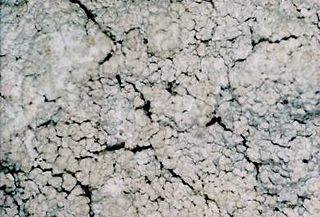
Lepraria is a genus of leprose (powdery) crustose lichens that grows on its substrate like patches of granular, caked up, mealy dust grains. Members of the genus are commonly called dust lichens. The main vegetative body (thallus) is made of patches of soredia. There are no known mechanisms for sexual reproduction, yet members of the genus continue to speciate. Some species can form marginal lobes and appear squamulose. Because of the morphological simplicity of the thallus and the absence of sexual structures, the composition of lichen products are important characters to distinguish between similar species in Lepraria.
Lepraria aurescens is a species of leprose lichen in the family Stereocaulaceae. It occurs in Thailand.
Lepraria achariana is a species of leprose lichen in the family Stereocaulaceae. It occurs at high elevations in Bolivia.
Lepraria alpina is a species of leprose lichen in the family Stereocaulaceae. It is found in Europe, North and South America, Antarctica, and Greenland, where it typically grows on rocks and rock-dwelling mosses in cool habitats.
Lepraria celata is a species of leprose lichen in the family Stereocaulaceae. The powdery greyish-green lichen, described as a new species in 2006, occurs in eastern Europe.
Leprocaulon coriense is a species of leprose lichen in the family Stereocaulaceae. It is found in Asia and Australia where it grows on various substrates, including rock, wood, bark, mosses and soil.
Lepraria crassissima is a species of leprose lichen in the family Stereocaulaceae. It occurs in Australia and Europe, when it grows on rocks and on mosses growing on rocks.
Lepraria cupressicola is a species of leprose lichen in the family Stereocaulaceae. It occurs in east and southeast Asia, where it grows on rocks, soil and bark in shaded, damp locations.

Lepraria diffusa is a species of leprose lichen in the family Stereocaulaceae. Originally described as Leproloma diffusum by Jack Laundon in 1989, it was reclassified into Lepraria in 2002. The lichen has a powdery thallus containing the secondary metabolite 4-oxypannaric acid 2-methylester. It grows on calcareous rocks and mosses in shaded areas across Asia, Europe, North America, and South America.
Lepraria eburnea is a widespread species of leprose lichen in the family Stereocaulaceae. It forms a powdery to cottony thallus that lacks clear boundaries and contains alectorialic acid as its main secondary metabolite. It grows on various substrates including rock, bark, and soil, showing a particular preference for calcareous materials in some regions. The lichen is found across Europe, North America, Australasia, and Greenland, occurring from sea level to alpine elevations, and is typically found in areas with high humidity. In North America, it is particularly abundant in the Great Lakes region and Maritime provinces of Canada, where it commonly grows as an epiphyte on tree bases in swampy areas.
Lepraria elobata is a species of leprose lichen in the family Stereocaulaceae. It occurs in Europe, North America, and Greenland. The bluish- to greenish-grey, powdery lichen grows on bark and sometimes on soil, wood, siliceous rock and mosses, usually in shady and humid habitats.

Lepraria friabilis is a species of leprose lichen in the family Stereocaulaceae. It has a disjunct distribution in the southeastern United States and southern California, where it grows exclusively on coniferous bark in humid environments such as swamps and stream valleys.
Lepraria gelida is a species of leprose lichen in the family Stereocaulaceae. It occurs in Greenland, Svalbard and the Russian Arctic islands, where it grows on soil, mosses and sometimes lichens, and rarely on bark.
Lepraria goughensis is a little-known species of leprose lichen in the family Stereocaulaceae. It is only known to occur on Gough Island in the south Atlantic Ocean.
Lepraria humida is a species of leprose lichen in the family Stereocaulaceae. Found in northern Europe and northeastern North America, it grows on siliceous rocks, often between mosses, typically on rain-sheltered damp surfaces.
Lepraria impossibilis is a species of leprose lichen in the family Stereocaulaceae. It forms a powdery to membranous thallus with a well-defined margin and distinctive secondary metabolites, including lecanoric acid and pannaric acid 6-methylester. The species is morphologically similar to Lepraria cupressicola and L. vouauxii but can be distinguished by its chemical composition. Lepraria impossibilis grows on tree bark, mosses, and soil-covered rocks, occurring in forested and open habitats across South and Central America, including El Salvador, Bolivia, Chile, and Peru, as well as in Iran.

Lepraria jackii is a species of leprose lichen in the family Stereocaulaceae, described by Tor Tønsberg in 1992. It forms a powdery thallus with variable colouration, ranging from pale green to straw-coloured, and grows on bark, mosses, wood, and rock surfaces in humid, sheltered environments. The species is characterised by its abundant soredia and distinctive secondary metabolites, including atranorin. Lepraria jackii has been recorded across Europe, North America, Asia, and Australia, preferring acidic substrates.
Lepraria leprolomopsis is a little-known species of corticolous (bark-dwelling) leprose lichen in the family Stereocaulaceae. It is found in Papua New Guinea.
Lepraria lobata is a species of leprose lichen in the family Stereocaulaceae. It is found in Australia, where it grows on bark, mosses on rock, and soil.
Lepraria lecanorica is a species of leprose lichen in the family Stereocaulaceae. It occurs in North and South America, where it grows on bark, rock, and soil substrates, typically in shaded locations.



